Outdoor Hotel Plants: Proven 2025 Buyer’s Guide for Hospitality Projects?
Guests judge your entrance in seconds. Faded leaves and loose planters cost trust. I deliver
outdoor hotel plants
that keep color, resist wind, and clean fast. Our outdoor hotel plants program standardizes materials and outcomes.
Yes. You choose
outdoor hotel plants
with UV-in-resin foliage,
316 stainless hardware,
anchored planters,
and a short cleaning cadence. Run a small pilot, record results, then scale across zones.
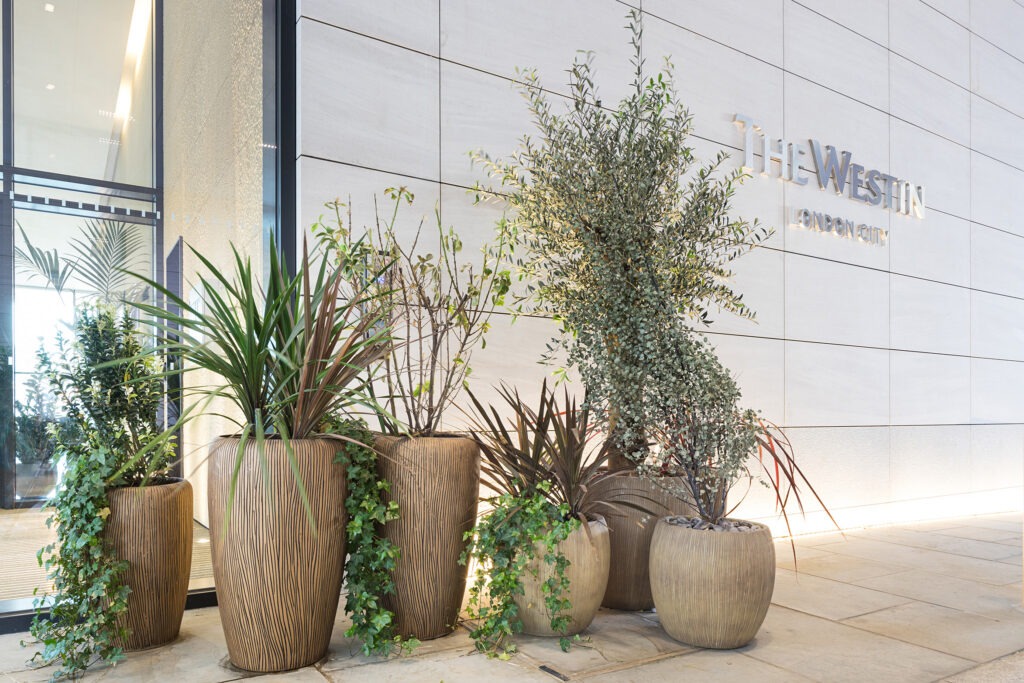
Use for: hero image to show a clean, anchored hotel entrance with fade-resistant greenery.
I keep this simple. You get a clear spec, a proof plan, and service stories you can copy. You avoid failure points. Your façade stays on brand. Your team stops firefighting. If you want deeper material choices for sun-exposed sites, you can read my external primer on sun exposure and then apply our process here: best outdoor artificial plants for full sun.
Why Outdoor Hotel Plants Drive ROI in Hospitality?
Waste from dead plants and emergency fixes hurts margin. Housekeeping time disappears. I replace chaos with
stable visuals and short routines.
Hotels invest in outdoor hotel plants to cut maintenance, hold brand standards through harsh weather, and protect reviews. Consistent color and safe placement reduce daily labor and surprise costs.
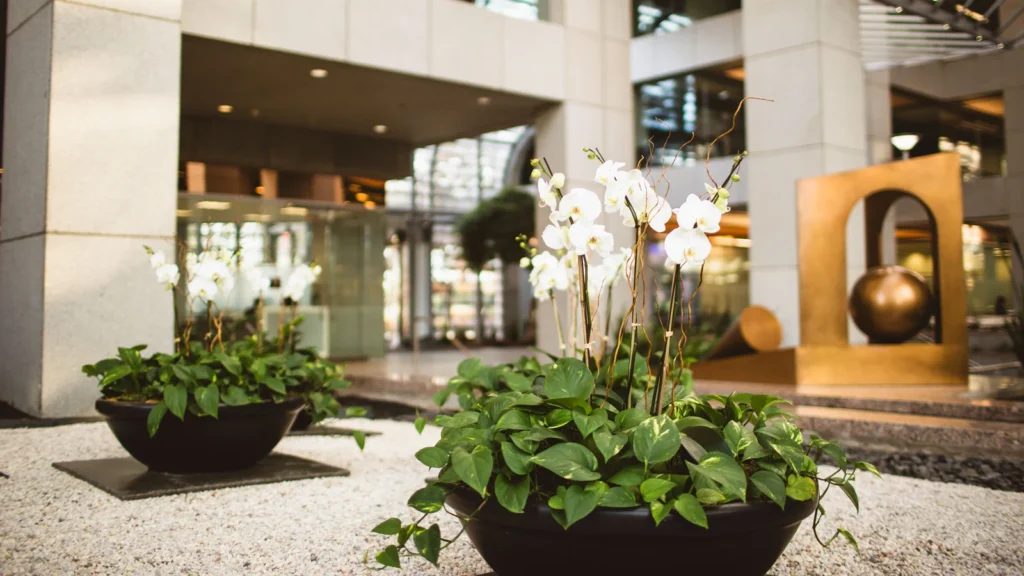
Use for: explaining financial and operational benefits to GMs and operations leads.
Reduced daily labor
Live plants struggle at entrances, rooftops, and pool decks. Heat and wind burn leaves. Salt stains hardware. Staff prune and replace often. Costs hide in overtime and rush deliveries. I remove that cycle. I specify UV-in-resin foliage, rigid frames, and marine-grade parts. The look holds with minutes of weekly care. If you compare realism vs durability for mixed programs, see Silk Flowers vs Faux Plants for quick trade-offs. These outdoor hotel plants reduce unplanned overtime.
Stable brand visuals
I lock color with a golden sample and dye-lot control. Photos stay consistent across seasons. Marketing stops retouching. Guests post better images. One Chicago business hotel saw lobby photos improve within a month. The GM said, “No more brown edges in reviews.” Outdoor hotel plants keep photography consistent across seasons.
Real client case
A Gulf Coast resort lost two live topiaries every month. I installed outdoor hotel plants with internal weight plates and concealed brackets. Housekeeping dusted weekly and rinsed monthly. Replacements dropped to zero. The façade looked the same in July and December. The resort moved budget from plant rescue to guest service.
Outdoor Hotel Plants Specs: UV, Wind & Salt That Matter?
Catalog photos look similar. The inside makes or breaks the install. I write specs you can check with a flashlight and a magnet. I specify outdoor hotel plants like an engineer, not a stylist.
Use UV-in-resin foliage with HALS, matte finish leaves, fiberglass or powder-coated frames, 316 stainless fasteners, double-wall FRP planters, and oversized drains with screens. Keep 5–10% spare parts for fast swaps.
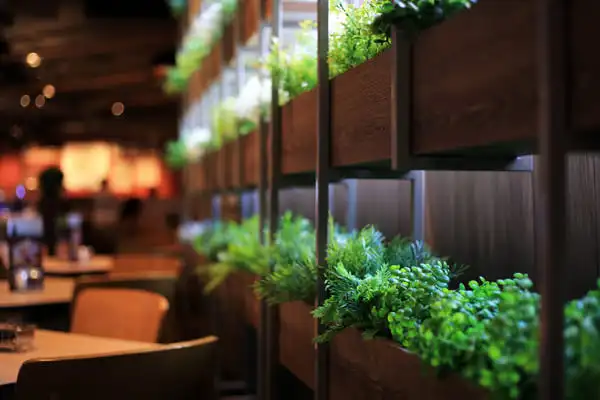
Use for: spec sheets and procurement checklists during vendor evaluation.
Foliage that keeps color
I ask for color masterbatch and HALS in the resin, not just a spray topcoat. This keeps color through the leaf. Scratches do not show white. I pick matte leaves to avoid shine in sun. I check stems for metal cores so shapes hold.
Frames and hardware that last
I favor fiberglass or powder-coated aluminum frames. They are light and stiff. I specify 316 vs 304 stainless differences for coastal sites. 304 tea-stains. Zinc rusts fast. I verify with a magnet test and paperwork. I note hardware sizes on the PO.
Planters and drains that behave
I use double-wall FRP or aluminum planters with ballast cavities. I drill 1–2 oversized drain holes and add stainless screens. I build a simple riser stack so water leaves in storms. I reject foam plugs that block flow. For outdoor installer lessons, I like these field notes on planter installation best practices.
Real client case
A Melbourne rooftop bar tried a vendor that used only UV spray. Fading showed after one summer. I replaced with outdoor hotel plants using UV-in-resin olive foliage and 316 hardware. The owner sent photos one year apart. No shift. Sales improved because the space looked premium at sunset, every day.
Best Outdoor Hotel Plants for Entrances, Rooftops & Pools?
Each zone needs a different mix. You match wind, sun, and sightlines. Then the space looks real and cleans fast. Outdoor hotel plants should match wind, shade, and guest flow.
Pick boxwood forms and bay laurel for entrances, palms and olives with tall grasses for rooftops, and low-shed tropicals for pool decks. Keep canopies controlled. Hide anchors in planters.
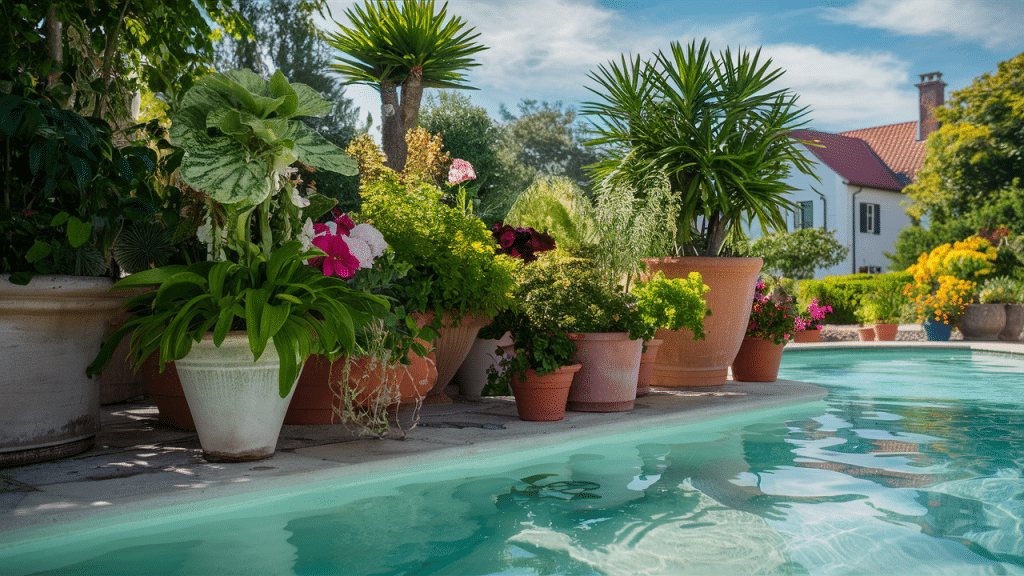
Use for: design boards that map plant types to entrances, rooftops, and pool decks.
Entrances that frame the brand
Entrances need formality and strength. I build pairs of boxwood cones or balls to frame doors. I add low greens at knee height to soften stone. These shapes read well from cars and phones. They also hide ballast and brackets inside tall planters. For a deeper entrance spec with diagrams, open my anchoring article here: Planters That Don’t Tip: Ballast, Anchoring & Drainage.
Rooftops that manage wind
Rooftops call for drama and caution. I choose hardy palms, olive trees, and tall grasses. Palms move a little. Grasses add motion and sound. I keep canopy height under control to limit sail effect. I place weight low. I add cable tie points at the trunk sleeve.
Pools that clean in minutes
Pool decks collect sunscreen and dust. I avoid dense faux blooms. I choose broad leaves and clean silhouettes. Staff wipe fast. I leave space for carts and trays. I use bases that resist splash and secure drains.
Real client case
A Vegas rooftop installed dense faux hydrangeas near a windy edge. They trapped dust and moved like sails. I swapped in olives and grasses, then used low succulents by seating. Dust dropped. The wind felt gentle. Guests stayed longer. The operator said turnover improved on hot days.
Outdoor Hotel Plants Anchoring & Drainage to Prevent Tip-Overs?
A pretty planter that moves is a hazard. I do not leave stability to chance. I prove it with hardware and a checklist. Outdoor hotel plants become liabilities if anchoring is skipped.
Anchor to structure where possible, size ballast to wind, and keep drains clear with screens and risers. Record torque at install and after the first storm.

Use for: installation manuals that show hidden brackets, ballast plates, and drain stacks.
Read the wind before you place
A plaza behind glass differs from a roof near an edge. Door gusts and vent paths create surprises. I walk the site. I hold a ribbon at likely spots. I place planters where air is calm. This costs nothing and prevents damage. For a longer walkthrough with diagrams, see our anchoring guide.
Build weight where it counts
I add hidden steel plates in base cavities for entrances. On roofs I add mechanical anchors with sleeves for service. I use anti-theft cables in public areas. I set a target weight so one person cannot shift the planter.
Keep water moving
I enlarge drain holes. I add stainless screens and risers. I avoid foam and tight pads that trap debris. I mark a rinse path so housekeeping can flush dust and salt. Drains that work keep the base clean and odor free.
Real client case
Near Dubai Marina, two planters slid into a water feature during a shamal. I rebuilt the bases with plates and four concealed brackets into the plinth. I added a small lip to deflect gusts. No movement since. The chief engineer now uses the same detail on every new zone.
Outdoor Hotel Plants Cleaning Cadence for 5-Star Standards?
Dust ruins realism. Guests post photos. I write cleaning plans that fit a real shift. No special gear. No drama. Outdoor hotel plants look real when dust control is simple.
Dust weekly with a blower and microfiber, wash monthly with neutral pH cleaner, and do a quarterly inspection with a small spare kit. Train once. Keep it on a two-page guide.
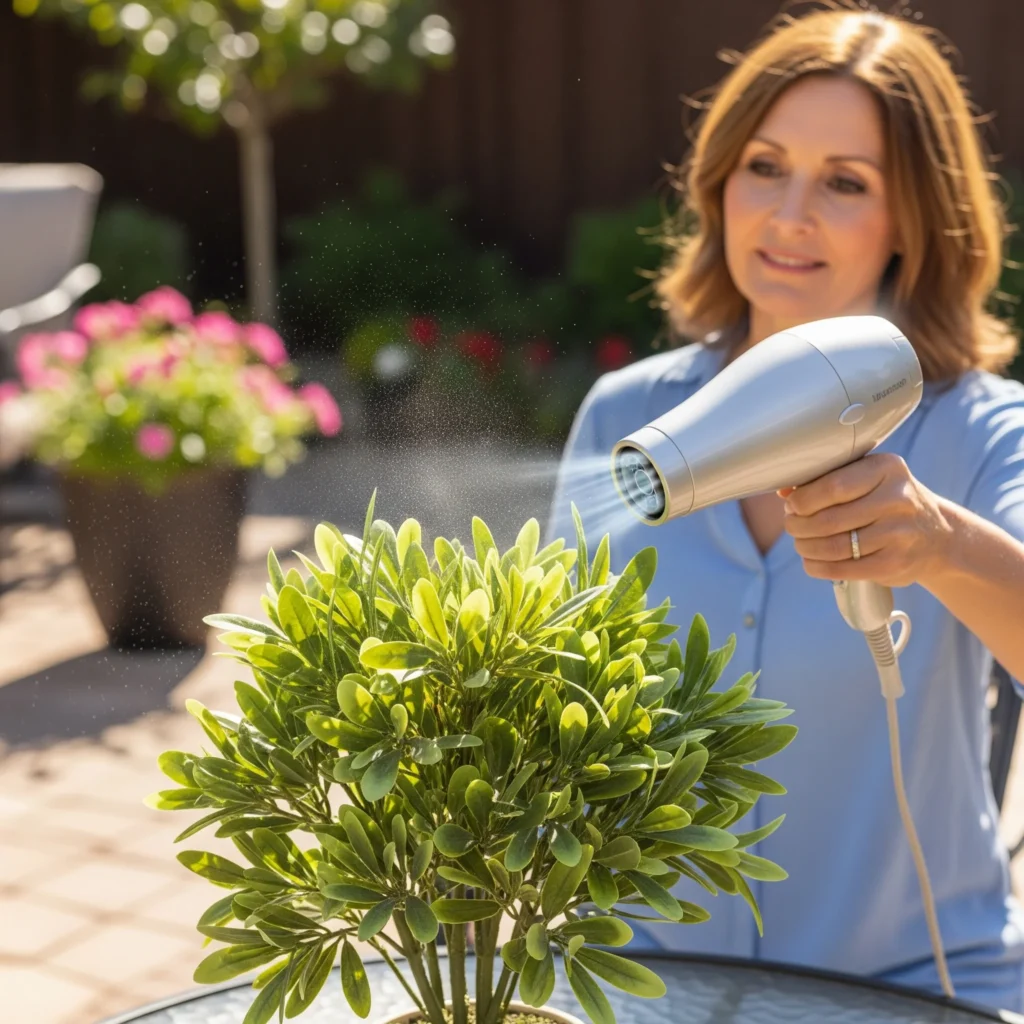
Use for: housekeeping SOPs that fit pre-opening or late-night shifts.
A weekly rhythm that takes minutes
Before lobby opens, housekeeping runs a small blower over planters, then wipes eye-level leaves with microfiber. This removes grit before it sticks. It takes minutes per zone. It keeps photos clean. My full-sun selection guide shows leaf textures that hide dust better on desert or coastal sites.
A monthly wash that resets the look
The team mixes neutral pH cleaner. They mist, wipe, and rinse. They check drains and visible screws. They wipe stainless with a dedicated cloth. If a scuff shows, they swap a leaf head from the spare bin. For shipping durability that eases unpacking, I insist on ISTA 3A packaging tests.
A quarterly check that prevents drift
Engineering walks the zones with my checklist. They log color, wobble, and torque. They compare one head with the golden sample under daylight. If the shift is visible, they plan a rotation. I keep 5–10% spares labeled by zone. When required, I provide NFPA 701 documentation for code reviews.
Real client case
A marina hotel in Florida cut daily plant care from ninety minutes to fifteen with this cadence. The lobby team moved the routine after night shift. Reviews started to mention “clean outdoor spaces.” That tells me the plan works. No one complains about fake plants. They just feel the space is fresh.
Sourcing Outdoor Hotel Plants from Reliable Commercial Silk Suppliers?
A good design fails if supply breaks. I qualify factories like safety vendors. I move from sample to pilot to roll-out. Outdoor hotel plants depend on factories that respect QA.
Audit samples, confirm HALS and 316 specs, require ISTA 3A and AQL plans, run a small pilot, and lock dye-lot control and spare parts. Keep records for fast reorders.
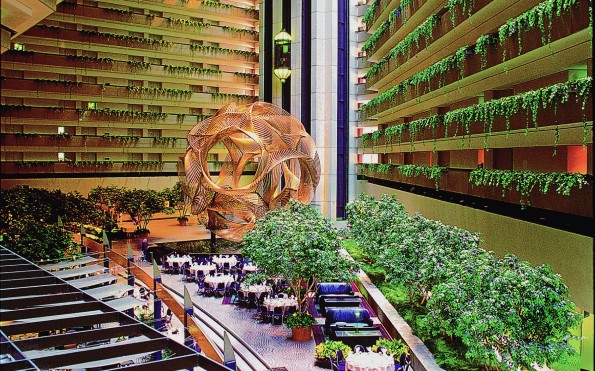
Use for: procurement playbooks and vendor scorecards before PO approval.
Samples that reveal the truth
I ask for leaves, stems, and a small assembled piece. I cut edges and check color through the section. I bend stems to test memory. I sun the parts for a week. I spray salt water and dry. Cheap parts fail fast. I document results.
Paperwork that prevents surprises
I want material sheets that reference HALS. I want hardware lists that call out 316 for coastal sites. I ask for ISTA 3A packaging test reports. I want AQL 2.5/4.0 for assembly. Good factories share in a day and admit limits. That honesty saves time.
Pilot that proves the program
I install one entrance and one rooftop bay. I track color, dust, and wobble for six to eight weeks. I write notes. I swap any weak parts. Only after proof do I scale. I then store spare heads and log dye-lot numbers.
Real client case
A U.S. brand faced a mismatch on twelve planters for a chain hotel. The first supplier changed dye-lot. I had the original code and sent new heads in four days. The terrace reopened on time. The chain now uses dye-lot control on every property.
Outdoor Hotel Plants Field Insights from Recent Hotel Installs?
I made mistakes. I learned rules that keep projects smooth. These notes save your time and budget. Outdoor hotel plants succeed when teams follow these basics.
Walk the wind before design. Lock color early. Hide anchors in the composition. Keep a spare kit on site. Train once with a simple guide. The system then runs itself.
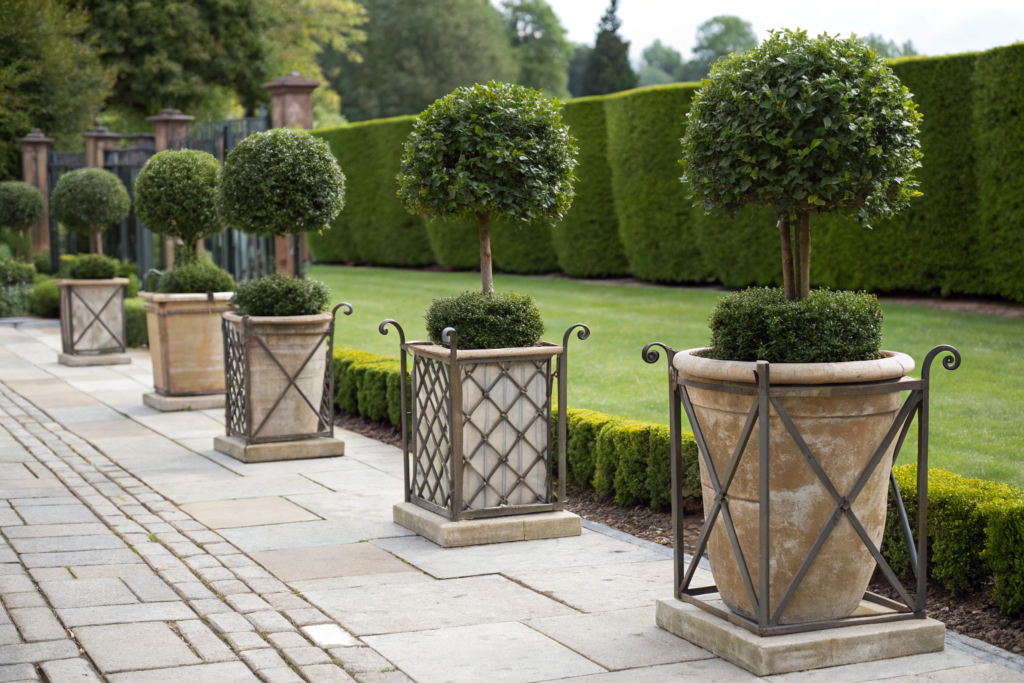
Use for: pre-installation site walks and team training sessions.
Walk first, then draw
Plans miss gusts from revolving doors, garage ramps, and vents. I test with a ribbon. I choose calm air. Tip-overs drop when placement is right. This is free and fast. For deeper wind and ballast notes, see our anchoring & drainage guide.
Lock color while you can
At mockup, I shoot photos in sun and shade with a neutral card. I write the dye-lot on the sample and the PO. I store the sample where managers can reach it. One minute now prevents weeks of “almost the same green.”
Design that hides the hardware
Guests should not see brackets. I bury plates in tall planters or under a low skirt of foliage. I keep access holes and file photos. Security likes hidden theft points.
Real client case
A boutique in Kyoto wanted soft cherry blooms at a portico all year. I built slim branches with matte petals. I used narrow FRP troughs with internal plates and hidden tie points. Rain season came and went. The look stayed gentle and premium. Brides stopped for photos every weekend. The owner sent a thank-you note with a photo of three couples lined up.
Conclusion
Strong specs, stable anchors, and a short cleaning rhythm keep outdoor hotel plants real while your team serves guests.
My Role
My Identity
Name: Jasmine
Brand: Botanic Blossoms
Email: jasmine@cnhycrafts.com
Position: Founder & CEO
Background & Achievements
I have more than ten years in floral and décor. I founded Botanic Blossoms to join creativity with sustainability. My team builds durable, beautiful products. We ship worldwide and serve hotels, venues, and retailers. Partners trust us because we solve problems fast and keep color consistent.
Company Overview
Botanic Blossoms delivers high-quality artificial flowers and greenery for homes and commercial spaces. We support weddings, corporate events, hospitality, and retail.
Business Model
We sell via our site, Amazon, eBay, Alibaba, and Global Sources. We support custom projects for size, color, and hardware. We design for UV, wind, and salt. We deliver samples fast and hold spare parts.
Target Customer Group
Sophia, age 30, runs a firm in events, interiors, and retail. She buys in bulk, values quality and reliable logistics, and prefers clear after-sales support. She searches on B2B platforms and wants a supplier who hits dates and solves issues without drama.
Core Competitive Advantages
1. High realism that looks great in photos.
2. Durability for harsh climates and open sites.
3. Custom options for unique briefs.
4. Eco-minded materials and efficient packaging.
B2B FAQ
- How long does color hold in full sun? Most sites keep rich color for 24–36 months with UV-in-resin foliage and the monthly wash. For heat and desert notes, see this full-sun guide.
- Can you ship planters pre-ballasted? Yes. I pre-fit plates and hardware. Engineering anchors on site, then signs the torque checklist. Install details are mapped in our anchoring article.
- What wind can your anchoring handle? Most projects cover 70–90 km/h gusts. I can engineer higher with added plates or deck anchors.
- Do you provide golden samples and dye-lot control? Yes. I label samples, store spare heads, and log dye-lot codes for clean reorders.
- What tools do we need for cleaning? A small blower, microfiber cloths, a soft brush, neutral pH cleaner, stainless wipes, and a compact torque wrench.
- Can we mix live and faux? Yes. I design hybrid beds. Live herbs near service zones and stable faux structure where sun and wind are harsh. For realism vs durability, read Silk vs Faux.
- How do you reduce shipping damage? ISTA 3A cartons, corner guards, bagged foliage, and zone-labeled screw packs. Each carton has a repack photo.
- What is your typical lead time? Samples in 7–10 days. Pilot in 2–3 weeks. Full roll-out in 25–35 days based on volume and hardware.
- Can you help with code compliance? I provide NFPA 701 documentation where required and advise on placement to fit local rules.
- Do you train staff? Yes. I run a short on-site session and leave a two-page guide with photos. Teams follow it without extra headcount.
Call-to-Action
Ready to spec your first entrance or rooftop?
